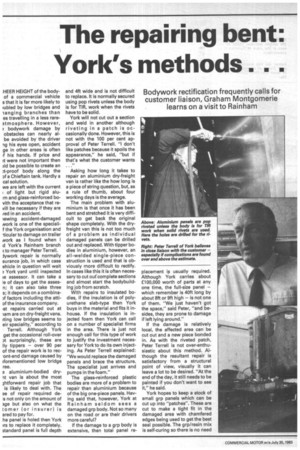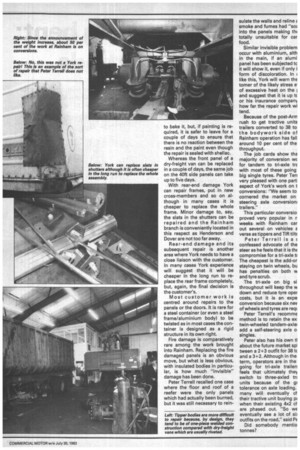The repairing bent: York's methods . . .
Page 30

Page 31

If you've noticed an error in this article please click here to report it so we can fix it.
Bodywork rectification frequently calls for customer liaison, Graham Montgornerie learns on a visit to Rainham
• HEER HEIGHT of the bodyof a commercial vehicle s that it is far more likely to lubled by low bridges and langing branches than es travelling in a less rareatmosphere. However, ) bodywork damage by obstacles can nearly albe avoided by the driver ig his eyes open, accident ge in other areas is often If his hands. If price and it were not important then /Id be possible to create an A-proof body along the Df a Chieftain tank. Hardly a cal solution.
we are left with the current of light but rigid alum and glass-reinforced bovith the acceptance that rewill be necessary if they are fed in an accident.
iewing accident-damaged Nork is one of the specialif the York organisation and tcular to damage on trailer Nork as I found when I d York's Rainham branch to manager Peter Terrell. iywork repair is normally surance job, in which case chicle in question will wait a York yard until inspected le assessor. It can take a le of days to get the assesn; it can also take three s; it depends on a combine)f factors including the attiof the insurance company.
■ st repairs carried out at lam are on dry-freight vans. Aing low bridges seems to eir speciality," according to
Terrell. Although York get the occasional roll-over Dt surprisingly, these are Ily tippers — over 90 per of the repair work is to rec.ont-end damage caused by Iforementioned low bridge ree.
a aluminium-bodied dryit van is about the most 3htforward repair job that is likely to deal with. The ae of repair required des not only on the amount of age but also on what the tomer (or insurer) is ared to pay for.
he panel is holed then York rs to replace it completely. standard panel is full depth and 4ft wide and is not difficult to replace. It is normally secured using pop rivets unless the body is for TIR, work when the rivets have to be solid.
York will not cut out a section and weld in another although riveting in a patch is occasionally done. However, this is not with the 100 per cent approval of Peter Terrell. "I don't like patches because it spoils the appearance," he said, "but if that's what the customer wants Asking how long it takes to repair an aluminium dry-freight van is rather like the how long is a piece of string question, but, as a rule of thumb, about four working days is the average.
The main problem with aluminium is that once it has been bent and stretched it is very difficult to get back the original shape completely. With the dryfreight van this is not too much of a problem as individual damaged panels can be drilled out and replaced. With tipper bodies in aluminium, however, an all-welded single-piece construction is used and that is obviously more difficult to rectify. In cases like this it is often necessary to cut out' complete sections and almost start the bodybuilding job from scratch.
With repairs to insulated bodies, if the insulation is of polyurethane slab-type then York buys in the material and fits it inhouse. If the insulation is injected foam then York can call on a number of specialist firms in the area. There is just not enough call for this type of work to justify the investment necessary for York to do its own injecting. As Peter Terrell explained: "We would replace the damaged panels and brace the structure. The specialist just arrives and pumps in the foam."
The glass-reinforced plastic bodies are more of a problem to repair than aluminium because of the big one-piece panels. Having said that, however, York at Rainham seldom sees a damaged grp body. Not so many on the road or are their drivers more careful?
If the damage to a grp body is extensive, then total panel re placement is usually required. Although York carries about £1 00,000 worth of parts at any one time, the full-size panel — which remember is 40ft long by about 8ft or 9ft high — is not one of them. "We just haven't got the space," said Peter, "and besides, they are prone to damage if left lying around."
If the damage is relatively local, the affected area can be cut out and a new piece bonded in. As with the riveted patch, Peter Terrell is not over-enthusiastic about this method. Although the resultant repair is satisfactory from a structural point of view, visually it can leave a lot to be desired. "At the end of the day, it still needs to be painted if you don't want to see it," he said.
York hopes to keep a stock of small grp panels which can be cut up into "patches". These are cut to make a tight fit in the damaged area with chamfered edges being used to get the best seal possible. The grp/resin mix is self-curing so there is no need to bake it, but, if painting is required, it is safer to leave for a couple of days to ensure that there is no reaction between the resin and the paint even though the repair is sealed with shellac.
Whereas the front panel of a dry-freight van can be replaced in a couple of days, the same job on the 40ft side panels can take up to five days.
With rear-end damage York can repair frames, put in new cross-members and so on although in many cases it is cheaper to replace the whole frame. Minor damage to, say, the slats in the shutters can be repaired and the Rainham branch is conveniently located in this respect as Henderson and Dover are not too far away.
Rear-end damage and its subsequent repair is another area where York needs to have a close liaison with the customer. In many cases York experience will suggest that it will be cheaper in the long run to replace the rear frame completely, but, again, the final decision is the customer's.
Most customer work is centred around repairs to the panels or the doors. It is rare for a steel container (or even a steel frame/aluminium body) to be twisted as in most cases the container is designed as a rigid structure in its own right.
Fire damage is comparatively rare among the work brought into Rainham. Replacing the fire damaged panels is an obvious move, but what is less obvious, with insulated bodies in particular, is how much "invisible" damage has been done.
Peter Terrell recalled one case where the floor and roof of a reefer were the only panels which had actually been burned, but it was still necessary to rein sulate the walls and reline E smoke and fumes had "soi into the panels making tht totally unsuitable for car food.
Similar invisible problem occur with aluminium, alth in the main, if an alumi panel has been subjected tc it will show it, even if only i form of discoloration. In like this, York will warn thE tomer of the likely stress e. of excessive heat on the I and suggest that it is up tc or his insurance company how far the repair work wi tend.
Because of the post-Arm rush to get tractive units trailers converted to 38 to the bodywork side of Rainham operation has fall around 10 per cent of the throughput.
The job cards show tha majority of conversion wc for tandem to tri-axle tri with most of these going big single tyres. Peter Teri very pleased with one part aspect of York's work on t conversions: "We seem to cornered the market on steering axle conversion: trailers."
This particular conversio proved very popular in r weeks with Rainham car out several on vehicles a verse as tippers and TIR tilts
Peter Terrell is a .1 confessed advocate of the steer as he feels that it is thE compromise for a tri-axle tr The cheapest is the add-or staying on twin wheels, bu has penalties on both vt■ and tyre scrub.
The tri-axle on big si throughout will keep the down and reduce tyre oper costs, but it is an expe conversion because six nev of wheels and tyres are reqt Peter Terrell's recomme method is to retain the ex twin-wheeled tandem-axle: add a self-steering axle o singles.
Peter also has his own tl about the future market spl tween a 2+3 outfit for 38 tc and a 3+2. Although in the term, operators are in the going for tri-axle trailer: feels that ultimately they switch to three-axled trt units because of the gi tolerance on axle loading. many will eventually cltheir tractive unit buying pi when their existing 4x2 are phased out. "So WE eventually see a lot of si) outfits on the road," said PE
Did somebody mentio tonnes?




















































































